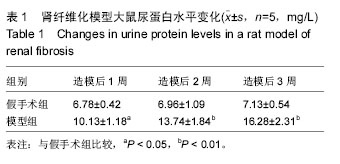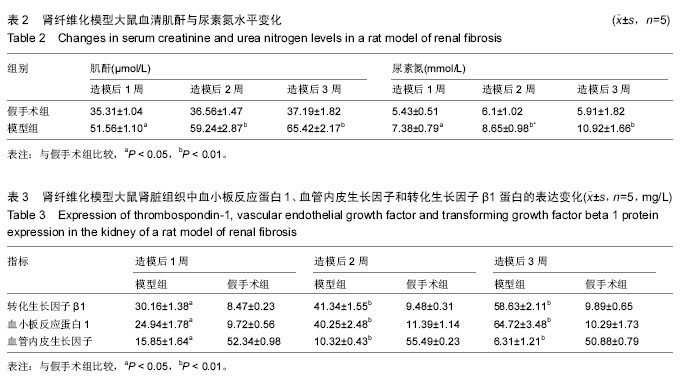| [1] Tang J, Liu CY, Lu MM,et al. Fluorofenidone protects against renal fibrosis by inhibiting STAT3 tyrosine phosphorylation. Mol Cell Biochem. 2015;407(1-2): 77-87.
[2] Qian Y,Peng K,Qiu C,et al. Novel epidermal growth factor receptor inhibitor attenuates angiotensin II-induced kidney fibrosis. Pharmacol Exp Ther.2016; 356(1):32-42.
[3] Chen CL, Chou KJ, Fang HC,et al. Progenitor-like cells derived from mouse kidney protect against renal fibrosis in a remnant kidney model via decreased endothelial mesenchymal transition. Stem Cell Res Ther. 2015;6:239.
[4] Nolan KA,Brennan EP,Scholz CC,et al. Paricalcitol protects against TGF-β1-induced fibrotic responses in hypoxia and stabilises HIF-α in renal epithelia. Exp Cell Res.2015;330(2):371-381.
[5] Ding Y,Kim Sl,Lee SY, et al. Autophagy regulates TGF-β expression and suppresses kidney fibrosis induced by unilateral ureteral obstruction. J Am Soc Nephrol. 2014;25(12):2835-2846.
[6] Bige N,Shweke N,Benhassine S,et al. Thrombospondin-1 plays a profibrotic and pro-inflammatory role during ureteric obstruction. Kidney Int. 2012;81(12):1226-1238.
[7] Cui W,Maimaitiyiming H,Qi X,et al. Thrombospondin 1 mediates renal dysfunction in a mouse model of high-fat diet-induced obesity. Am J Physiol Renal Physiol. 2013;305(6):F871-880.
[8] Hugo C1, Kang DH, Johnson RJ.Sustained expression of thrombospondin-1 is associated with the development of glomerular and tubulointerstitial fibrosis in the remnant kidney model.Nephron. 2002; 90(4):460-470.
[9] Kang DH, Anderson S, Kim YG,et al.Impaired angiogenesis in the aging kidney: vascular endothelial growth factor and thrombospondin-1 in renal disease.Am J Kidney Dis. 2001;37(3):601-611.
[10] Ma H, Li XH, Li Z, et al.Localized expressing tendency of nuclear transcription factor kappa-B, pro-fibrosis genetic factors and fibronectin mRNA in renal tissues in proteinuria overload nephrotic young rats].Zhonghua Er Ke Za Zhi. 2005; 43(11):814-818.
[11] 韩红,孙东,麻艳艳,等.单侧输尿管梗阻模型小鼠肾脏微血管损伤与肾间质纤维化的关系研究[J].中国病理生理杂志, 2010, 26(12):2478-2486.
[12] Yan J, Zhang Z, Yang J,et al. JAK3/STAT6 Stimulates Bone Marrow-Derived Fibroblast Activation in Renal Fibrosis.J Am Soc Nephrol. 2015;26(12):3060-3071.
[13] Sakai N, Wada T.T Helper 2 Cytokine Signaling in Bone Marrow-Derived Fibroblasts: A Target for Renal Fibrosis.J Am Soc Nephrol. 2015; 26(12):2896-2898.
[14] Nashan B, Schemmer P, Braun F,et al. Evaluating the efficacy, safety and evolution of renal function with early initiation of everolimus-facilitated tacrolimus reduction in de novo liver transplant recipients: Study protocol for a randomized controlled trial. Trials. 2015; 16:118.
[15] Racca MA, Novoa PA, Rodríguez I,et al. Renal dysfunction and intragraft proMMP9 activity in renal transplant recipients with interstitial fibrosis and tubular atrophy. Transpl Int. 2015;28(1):71-78.
[16] Hirt-Minkowski P, Marti HP, Hönger G, et al.Correlation of serum and urinary matrix metalloproteases/tissue inhibitors of metalloproteases with subclinical allograft fibrosis in renal transplantation.Transpl Immunol. 2014; 30(1):1-6.
[17] Nozue T, Yamamoto S, Tohyama S,et al. Impacts of estimated glomerular filtration rate on coronary atherosclerosis and plaque composition before and during statin therapy in patients with normal to mild renal dysfunction: subanalysis of the TRUTH study. Nephrology (Carlton). 2012;17(7):628-635.
[18] Rivelli RF, Gonçalves RT, Leite M Jr,et al. Early withdrawal of calcineurin inhibitor from a sirolimus-based immunosuppression stabilizes fibrosis and the transforming growth factor-β signalling pathway in kidney transplant. Nephrology (Carlton). 2015;20(3):168-176.
[19] Tanaka Y, Kume S, Araki H,et al. 1-Methylnicotinamide ameliorates lipotoxicity-induced oxidative stress and cell death in kidney proximal tubularcells. Free Radic Biol Med. 2015;89:831-841.
[20] Hou T, Xiao Z, Li Y,et al. Norcantharidin inhibits renal interstitial fibrosis by downregulating PP2Ac expression. Am J Transl Res. 2015;7(11):2199-211.
[21] Lu Z, Zeng Y, Lu F,et al. Rhubarb Enema Attenuates Renal Tubulointerstitial Fibrosis in 5/6 Nephrectomized Rats by Alleviating Indoxyl Sulfate Overload. PLoS One. 2015;10(12):e0144726.
[22] Hirata M, Tashiro Y, Aizawa K,et al. Epoetin beta pegol alleviates oxidative stress and exacerbation of renal damage from iron deposition, thereby delaying CKD progression in progressive glomerulonephritis rats. Physiol Rep. 2015;3(12). pii: e12637.
[23] 姜汉杰,李婉,王辰,等. 丹参粉针剂对单侧输尿管结扎大鼠肾纤维化的保护作用[J].中国新药杂志, 2015,24(22): 2606-2631.
[24] Belmiro CL, Gonçalves RG, Kozlowski EO,et al. Dermatan sulfate reduces monocyte chemoattractant protein 1 and TGF-β production, as well as macrophage recruitment and myofibroblast accumulation in mice with unilateral ureteral obstruction. Braz J Med Biol Res. 2011;44(7):624-633.
[25] Kim D, Lee AS, Jung YJ,et al. Tamoxifen ameliorates renal tubulointerstitial fibrosis by modulation of estrogen receptor α-mediated transforming growth factor-β1/Smad signaling pathway. Nephrol Dial Transplant. 2014;29(11):2043-2053.
[26] Nutter F, Khwaja A, Haylor J. Seliciclib inhibits renal hypertrophy but not fibrosis in the rat following subtotal nephrectomy. Nephron Exp Nephrol. 2012;122(3-4): 114-122.
[27] Kierulf-Lassen C, Kristensen ML, Birn H,et al. No Effect of Remote Ischemic Conditioning Strategies on Recovery from Renal Ischemia-Reperfusion Injury and Protective Molecular Mediators. PLoS One. 2015; 10(12): e0146109.
[28] Elshiekh M, Kadkhodaee M, Seifi B,et al. Ameliorative Effect of Recombinant Human Erythropoietin and Ischemic Preconditioning on Renal Ischemia Reperfusion Injury in Rats. Nephrourol Mon. 2015; 7(6):e31152.
[29] Chakrabarti S, Syme HM, Brown CA, et al. Histomorphometry of feline chronic kidney disease and correlation with markers of renal dysfunction. Vet Pathol. 2013;50:147–155.
[30] 张改华,饶向荣.急性肾损伤:慢性肾脏病进展至终末期肾病的跳板[J].中国中西医结合肾病杂志,2013,14(9): 830-832.
[31] Murugan R, Kellum JA. Acute kidney injury: what’s the prognosis? Nat Rev Nephrol. 2011;7:209-217. |
.jpg)



.jpg)
.jpg)